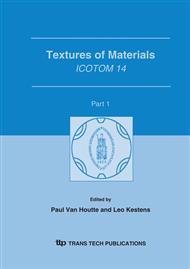p.1343
p.1353
p.1359
p.1365
p.1371
p.1377
p.1383
p.1389
p.1395
The Texture Effect on Diffusion Barrier Property on TiN Films between Copper and Si Wafer
Abstract:
TiN thin films are widely used as a coating material due to their good mechanical and conductivity properties, high thermal properties, strong erosion and corrosion resistance. Also TiN has been used in Si devices as a diffusion barrier material for Al and Cu-based metallization. The uniform and dense structure of thin films is influenced by the texture of films. It was good to have uniform and dense structure and bad to have an open columnar structure in TiN thin films. Therefore, the property of diffusion barrier of the TiN films in semiconductor also is related to the texture and microstructure of TiN coated layer. In this study, the relationship between the texture and microstructure and the best diffusion barrier propertiy of TiN coated films (by PVD and MOCVD) on semiconductor devices (Cu/TiN/SiO2/Si layer) were investigated under different processing conditions and textures. The property of diffusion barrier for Cu of physical vapor deposited TiN thin films is better than that of metal organic chemical vapor deposited TiN thin films. Also the property of diffusion barrier for Cu of (111) textured TiN thin films is better than that of (200) textured TiN thin films.
Info:
Periodical:
Pages:
1371-1376
Citation:
Online since:
September 2005
Authors:
Price:
Сopyright:
© 2005 Trans Tech Publications Ltd. All Rights Reserved
Share:
Citation:


